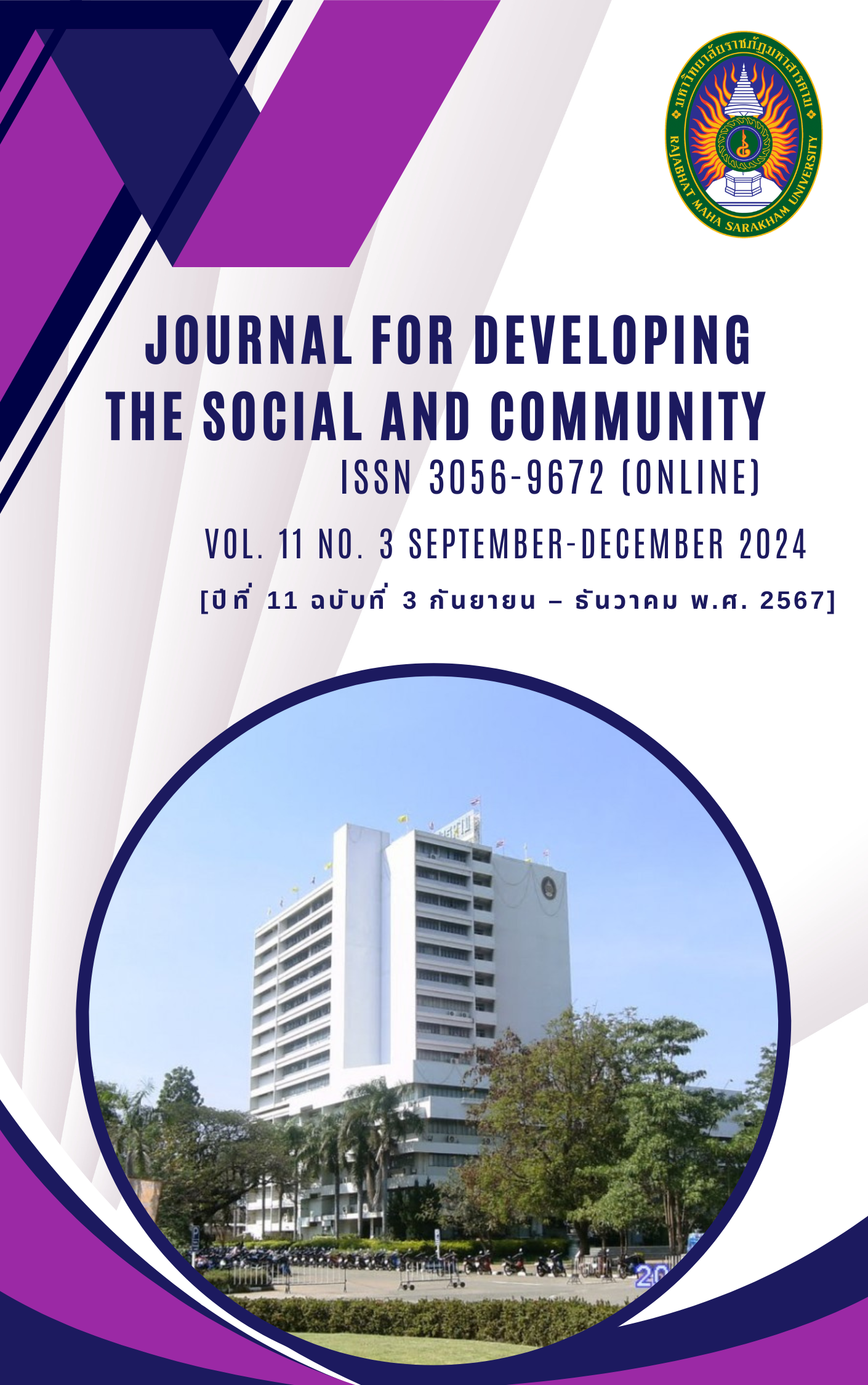Assessment of the Buddhist School Project at Kae Dam Wittayakarn School Maha Sarakham Province
Keywords:
behavior, The BuddhistAbstract
The objective of this developmental research was to evaluate the Buddhist Oriented School Project of Kaedam Wittayakhan School. The researcher undertook this Project through Research and Development (R & D) process divided into the following 4 stages: The first step was to establish the policies with the development plan of the Buddhist Oriented Kaedam Wittayakhan School. The second stage was to appoint the performance Committee through meeting, making the development plan with the operational plan for the activities of the Project and budget allocation. The third phase was to implement the activities of the Buddhist Oriented Kaedam Wittayakhan School. The fourth step was to check and evaluate the Project. The next phase was to reflect the performance for continuous improvement. The final stage was the result of the Project as the empirical evidence. The researcher has developed the instrument for appraisal with the standard criteria for the operations on the Buddhist Oriented Kaedam Wittayakhan School through CIPP Model.
According to the evaluation of the Buddhist Oriented School Project of Kaedam Wittayakhan School, Mahasarakham Province, the findings of the study were as follows:
PART 1 The evaluation for the operations on the Buddhist Oriented Kaedam Wittayakhan School through CIPP Model.
- The overall context evaluation with the appropriateness, as well as the
congruence among the Project objectives and the following different contexts: the policies of the Office of the Basic Education Commission, the policies of the Secondary Educational Service Area Office 26, and those of Kaedam Wittayakhan School, the vision, the uniqueness with identity, the goals, the strategies, the necessities and needs of the School was revealed that the administrators, instructors and educational personnel with the Basic Educational Board evaluated the operations in high level (X = 4.39, S.D. = 0.62). From the descending order of each consideration, this study showed that the first consideration at the highest level (X = 4.61, S.D. = 0.53) was this Project congruent with the policies of the Secondary Educational Service Area Office 26. The next one at the highest level (X = 4.54, S.D. = 0.56) was the knowledge with understanding of the Office of the Basic Education Commission toward the principles of the Buddhist Oriented School. The latter aspect at the highest level (X =4.50, S.D. = 0.59) respectively was the appropriateness and the clarity on the principle with rationale of the Buddhist Oriented School Project. The consideration at the lowest rank showed the Project evaluation at high level (X = 4.16, S.D. = 0.66) about the congruence with the students’ needs and interests.
- The overall input evaluation of the administrators, instructors and the
educational personnel at Kaedam Wittayakhan School, Mahasarakham Province, was in high level (X = 3.93, S.D. = 0.70). From the descending order of each consideration, this study showed that the first consideration in high level (X = 4.15, S.D. = 0.63) was the personnel. The next one at high level (X = 4.04, S.D. = 0.77) was the administration and management. The latter aspect at high level (X =3.79, S.D. = 0.68) respectively was the budget. The consideration at the lowest rank showed the Project evaluation at high level (X = 3.74, S.D. = 0.79) about the supplies, materials, tools and venues.
- The overall process evaluation in high level (X = 4.10, S.D. = 0.80) showed about
the administrators, the lecturers, as well as the educational staff, along with the students of Kaedam Wittayakhan School. From the descending order of each consideration, this research was revealed that the first consideration in high level (X = 4.14, S.D. = 0.83) was the activities of the Project. The next one at high level (X = 4.10, S.D. = 0.80) was the atmosphere with interaction toward the Project activities. The next one at high level (X = 4.04, S.D. = 0.77) respectively was the learning management, instructional aids, learning sources, together with assessment and measurement.
- The overall product evaluation in high level (X = 4.14, S.D. = 0.79) showed about
the outputs of the administrators, the lecturers, as well as the educational staff, along with the students and the guardians of Kaedam Wittayakhan School, Mahasarakham Province. From the descending order of each consideration, this research showed that the first consideration in high level (X = 4.18, S.D. = 0.79) was social development (precept). The next one at high level (X = 4.16, S.D. = 0.82) was mental development (mind). The next ones at the same statistic in high level (X = 4.11, S.D. = 0.78) consisted of physical development (body) and intellectual development (wisdom).
PART 2 The opinions on impact evaluation.
The overall impact evaluation in high level (X = 4.21, S.D. = 0.78) showed about the effect toward the residents within the community. The next one at high level (X = 4.18, S.D. = 0.77) was the effect on the monasteries. The latter aspect at high level (X = 4.15, S.D. = 0.79) respectively was the impact toward the School.
References
Alkin, M.C. (1972). Evaluation theory development. In C. Weiss (Ed.). Evaluation action programs. Boston: Allyn & Bacon.
Buasan, R. (1997). Evaluation of Evaluation Research Projects. Bangkok: Compact Print Co., Ltd.
Innovation Development Office for Educational Management, Office of the Basic Education Commission. (2005). Guidelines for the Operation of Buddhist Schools. (6thed). Bangkok: The Transport and Parcel Organization.
Inyai, C. (2010). Project Evaluation. Bangkok: Chulalongkorn University.
Kanjanawasi, S. (2007). Evaluation Theory. (7thed). Bangkok: Chulalongkorn University Press.
Mahachulalongkornrajavidyalaya University. (2004). Buddhist School. Bangkok: Mahachulalongkornrajavidyalaya University.
Ministry of Education. (2012). Educational Development Policy and Strategy of the Ministry of Education 2012-2015. Bangkok: Agricultural Cooperative Printing House of Thailand Co., Ltd.
Phithiyasuwat, S. (2004). Collection of Articles on Project Evaluation, Volume 4. (6thed.). Bangkok: Chulalongkorn University.
Phongsri, P. (2006). Project Evaluation Techniques. Bangkok: Phimngam Partnership Limited.
Phra Thammapitok (Por. Payutto). (2004). Towards the Buddhist Way. (3rded). Bangkok: Usa Printing
Phra Thepsophon (Prayoon Thammajitto). (2004). Buddhist School for Thai Society. Bangkok: Mahachulalongkornrajavidyalaya University.
Phromwong, Y. (2010). Evaluation of the Buddhist School Project of Ban Wang Fang School, Fang District, Chiang Mai Province. Chiang Mai: Chiang Mai University.
Prasitratsin, S. (2004). Project Evaluation Research. Bangkok: Image Printing.
Provus, M. (1971). Discrepency Evaluation for Educational Program Improvement and Assessment. Berkeley CA: McCutchan.
Rangchaikulwibulsri, Y. (2003). Project Evaluation. Bangkok: Chulalongkorn University Press.
Rotprasert, P. (1994). Project Management. Bangkok: Netikul Printing House.
Sirirat, T. (2001). Project Evaluation Development Planning. Bangkok: Thailand Research Fund.
Stufflebeam, D. L. et al. (1971). Educational Evaluation and Decision Making. Itasca Illinois: Peacock Publishing.
Wibulsri, Y. (1999). Project Evaluation: Concepts and Practices. Bangkok: Chulalongkorn University.
Downloads
Published
How to Cite
Issue
Section
License
Copyright (c) 2024 Journal for Developing the Social and Community

This work is licensed under a Creative Commons Attribution-NonCommercial-NoDerivatives 4.0 International License.
Articles that are published are copyrighted by the authors of the articles







